Egyptian Hieroglyphs › Thoth » Ancient origins
Articles and Definitions › Contents
- Egyptian Hieroglyphs › Antique Origins
- Thoth › Who Was
Ancient civilizations › Historical and archaeological sites
Egyptian Hieroglyphs › Antique Origins
Definition and Origins

The Egyptian hieroglyphic script was one of the writing systems used by ancient Egyptians to represent their language.Because of their pictorial elegance, Herodotus and other important Greeks believed that Egyptian hieroglyphs were something sacred, so they referred to them as 'holy writing'. Thus, the word hieroglyph comes from the Greek hiero 'holy' and glypho 'writing'. In the ancient Egyptian language, hieroglyphs were called medu netjer, 'the gods' words' as it was believed that writing was an invention of the gods.
The script was composed of three basic types of signs: logograms, representing words; phonograms, representing sounds;and determinatives, placed at the end of the word to help clarify its meaning. As a result, the number of signs used by the Egyptians was much higher compared to alphabetical systems, with over a thousand different hieroglyphs in use initially and later reduced to about 750 during the Middle Kingdom (2055-1650 BCE). In the 1820s CE, Frenchman Jean-François Champollion famously deciphered hieroglyphs using the 2nd century BCE Rosetta Stone with its triple text of Hieroglyphic, Demotic and Greek. Egyptian hieroglyphs are read either in columns from top to bottom or in rows from the right or from the left.
ORIGIN OF EGYPTIAN HIEROGLYPHS
Like most ancient scripts, the origin of Egyptian hieroglyphs is poorly understood. There are, however, several hypotheses that have been put forth. One of the most convincing views claims that they derive from rock pictures produced by prehistoric hunting communities living in the desert west of the Nile, who were apparently familiar with the concept of communicating by means of visual imagery. Some of the motifs depicted on these rock images are also found on pottery vessels of early Pre-dynastic cultures in Egypt. This is especially marked during the Naqada II period (c. 3500-3200 BCE). The vessels were buried in tombs, and it is also in tombs of the Naqada III/Dynasty 0 period (c. 3200-3000 BCE) that the earliest securely dated examples of Egyptian hieroglyphs have been found.
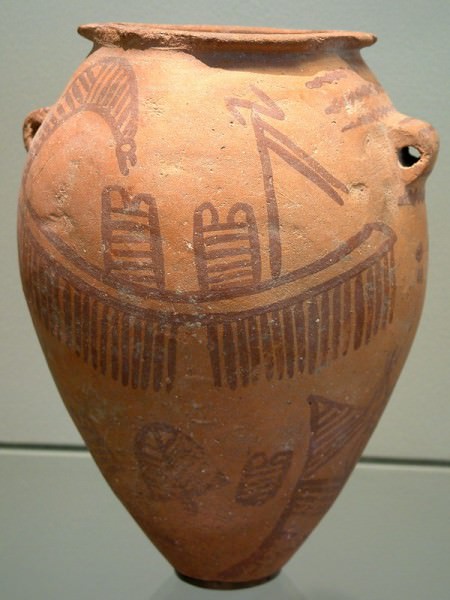
Naqada II pottery
In Abydos' cemetery U, tomb j, a member of the local elite was buried around 3100 BCE. He was a wealthy man, probably a ruler, and he was buried with several goods, including hundreds of jars, an ivory sceptre and other items. Many of these objects were looted and we know about them due to the approximately 150 surviving labels, which contain the earliest known writing in Egypt.
MATERIAL FORM & USE OF EGYPTIAN HIEROGLYPHS
The labels found in the Abydos Uj tomb were carved on small rectangles made of wood or ivory with a hole in their corner so they could be attached to different goods. Other inscribed surfaces such as ceramic, metal and stone (both flakes and stelae) are also known from early royal tombs.
Papyrus, the chief portable writing medium in Egypt, appears during the First dynasty (c. 3000-2890 BCE): the earliest surviving example we know of comes from a blank roll found in the Tomb of Hemaka, an official of King Den. Egyptian scribes used papyrus and other alternative writing surfaces, including writing boards generally made of wood. Until the end of the Eighteenth dynasty (1550-1295 BCE), these boards were covered with a layer of white plaster which could be washed and replastered, providing a convenient reusable surface. Examples of clay tablets, a popular medium in Mesopotamia, dating to the late Old Kingdom (2686-2160 BCE) were found in the Dakhla Oasis, an area far away from the various locations where papyrus was produced. Bone, metal and leather were other type of materials used for writing. Surviving inscriptions on leather dating back to the New Kingdom (1550-1069 BCE) have also been found, but the preservation of leather is poor compared to papyrus, so there is no certainty about how extensively leather was used.
The inscriptions found at Abydos display different types of information: some of them are numbers, others are believed to indicate the origin of the goods, and the most complex show administrative information related to economic activities controlled by the ruler. In tombs from Dynasty 0, the signs found on pottery and stone vessels (and also on the labels attached to them) were used to indicate ownership of their content, probably connected with taxation and other accounting data. The signs on pottery vessels become increasingly standardized and since these pot-marks are believed to express information about the contents of the vessels (including their provenance), this tendency may reflect a growth in the complexity of record keeping and administrative control.
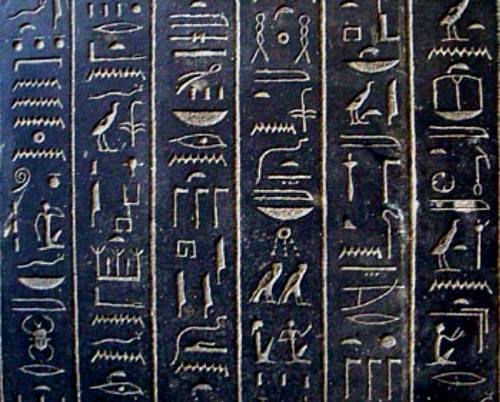
Detail from the sarcophagus of Ankhnesneferibre
Towards the Late Pre-dynastic/ Early dynastic transition (c. 3000 BCE), we find examples of writing in the context of royal art to commemorate royal achievements. In this case, writing is found on ceremonial maceheads, funerary stone stelae and votive palettes: the function of these items was to honour the memory of the rulers both in terms of the ruler's achievements during their life and his relationship with the various gods and goddesses. Around 2500 BCE we find the oldest known examples of Egyptian literature, the “ Pyramid Texts”, engraved on pyramids ' walls, and later, around 2000 BCE, there emerged a new type of text known as the Coffin Texts, a set of magical and liturgical spells inscribed on coffins.
DEVELOPMENT OF ANCIENT HIEROGLYPHS
As Egyptian writing evolved during its long history, different versions of the Egyptian hieroglyphic script were developed. In addition to the traditional hieroglyphs, there were also two cursive equivalents: hieratic and demotic.
Hieroglyphic
This was the oldest version of the script, characterized by its elegant pictorial appearance. These signs are typically founnd in monument inscriptions and funerary contexts.
Hieratic
Encouraged by priests and temple scribes who wanted to simplify the process of writing, hieroglyphs became gradually stylized and derived into the hieratic 'priestly' script. It is believed that hieratic was invented and developed more or less simultaneously with the hieroglyphic script. Some of the hieroglyphs found in tombs dated to the c. 3200-3000 BCE period were in the form of royal serekhs, a stylized format of the king's name. Some serekhs written on pottery vessels had hieroglyphs in cursive format, possibly a premature stage of hieratic. Hieratic was always written from right to left, mostly on ostraca (pottery sherds) and papyrus, and it was used not only for religious purposes, but also for public, commercial and private documents.
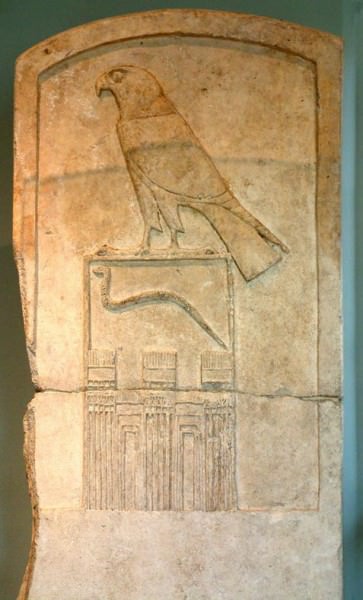
Egyptian Serekh
Demotic
An even more abbreviated script lacking any pictorial trace known as demotic 'popular' came in use around the 7th century BCE. The Egyptians called it sekh shat, "writing for documents". With the exception of religious and funerary inscriptions, demotic gradually replaced hieratic. While hieratic still carries some traces of the pictorial hieroglyphic appearance, demotic has no pictorial trace and it is difficult to link demotic signs with its equivalent hieroglyph.
LEGENDS ON THE ORIGIN OF EGYPTIAN HIEROGLYPHS
According to Egyptian tradition, the god Thoth created writing to make the Egyptians wiser and to strengthen their memory.The god Re, however, disagreed: he said that delivering the hieroglyphs to humanity would cause them to contemplate their memory and history through written documents rather than relying on their actual memories passed down through generations.Writing, in Re's view, would weaken people's memory and wisdom. Despite the will of Re, Thoth gave the techniques of writing to a select number of Egyptians, the scribes. In ancient Egypt, scribes were highly respected for their knowledge and skill in using this gift of the gods and this position was a vehicle of upward social mobility.
DECIPHERING HIEROGLYPHS
For many years hieroglyphs were not understood at all. In 1798 CE Napoleon Bonaparte went to Egypt with many researchers and they copied several Egyptian texts and images. One year later, the Rosetta Stone was found, a decree of Ptolemy V, with the same text written in Greek, demotic and hieroglyphic writing.
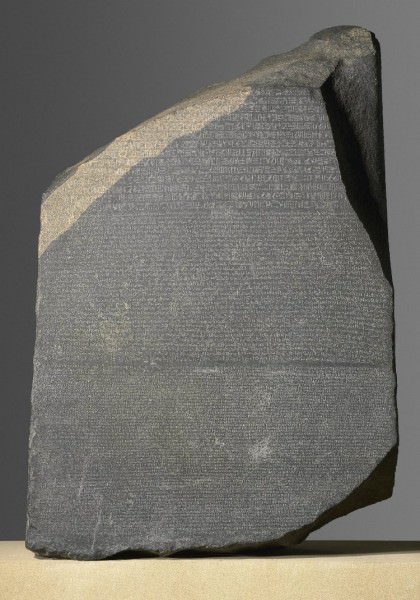
Rosetta Stone
Finally, Jean-François Champollion unravelled the mystery. He identified the name of Ptolemy V written on the Rosetta Stone, by comparing the hieroglyphs with the Greek translation. Then, he continued to study the names, using an obelisk from Philae (now in Dorset, England ). The obelisk had the name of Ptolemy and Cleopatra written on it. This made it possible to conclude that the ancient Egyptian hieroglyphic writing was a mixture of signals representing sounds, ideas and words, not a common alphabet. Champollion's achievement in deciphering the Rosetta Stone unlocked the secret of the ancient Egyptian writing system and allowed the world to finally read into Egyptian history.
DECLINE OF EGYPTIAN HIEROGLYPHS
During the Ptolemaic (332-30 BCE) and the Roman Period (30 BCE-395 CE) in Egypt, Greek and Roman culture became increasingly influential. Towards the 2nd century CE, Christianity started to displace some of the traditional Egyptian cults.Christianized Egyptians developed the Coptic alphabet (an offshoot of the Greek uncial alphabet), the final stage in the development of the Egyptian language, employed to represent their language.

Champollion's notes from the Rosetta Stone
Examples of the full 32-letter Coptic alphabet are recorded as early as the 2nd century CE. Its use not only reflects the expansion of Christianity in Egypt but it also represents a major cultural breakup: Coptic was the first alphabetic script used in the Egyptian language. Eventually, Egyptian hieroglyphs were replaced by the Coptic script. Only a few signs from the demotic script survived in the Coptic alphabet. The written language of the old gods plunged into oblivion for nearly two millennia, until Champollion's great discovery.
Thoth › Who Was
Definition and Origins
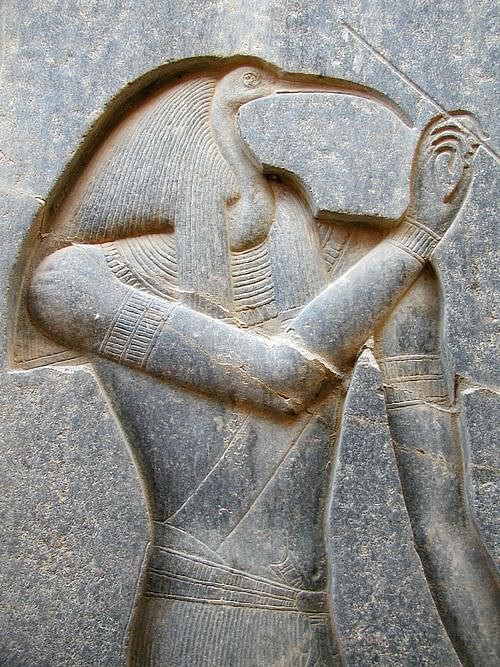
Thoth is the Egyptian god of writing, magic, wisdom, and the moon. He was one of the most important gods of ancient Egyptalternately said to be self-created or born of the seed of Horus from the forehead of Set. As the son of these two deities, who represented order and chaos respectively, he was also the god of equilibrium and balance and associated closely with both the principle of ma'at (divine balance) and the goddess Ma'at who personified this principle (and who was sometimes seen as his wife). Another of his consorts was the goddess Nehemetawy ('She Who Embraces Those In Need") a protector goddess. In his form as A'an, Thoth presided over the judgment of the dead with Osiris in the Hall of the Truth and those souls who feared they might not pass through the judgment safely were encouraged to call upon Thoth for help. The consort most often associated with Thoth was Seshat, goddess of writing, the keeper of books, and patron goddess of libraries and librarians who was alternately his wife or daughter.
Worship of Thoth began in Lower Egypt most likely in the Pre-Dynastic Period (c. 6000-3150 BCE) and continued through the Ptolemaic Period (323-30 BCE), the last dynastic era of Egyptian history, marking Thoth's veneration as among the longest of the Egyptian gods or any deity from any civilization. His name was often taken by the kings of Egypt (example, Tuthmoses - "Born of Thoth"), scribes, and priests. He is most commonly depicted as a man with the head of an ibis or a seated baboon with or without a lunar disc above his head. He was the patron god of scribes and it was said that scribes would pour out one drop of their ink in Thoth's honor before they began their daily work.
NAME & ORIGIN
Thoth's Egyptian name was Djehuty (also dhwty ) meaning "He Who is Like the Ibis". The ibis was a sacred bird in ancient Egypt as well as a popular pet and associated with wisdom. Other forms of his name are Jehuti, Tahuti, Tehuti, Zehuti, Techu, Tetu, and Lord of the Khemenu (the later city of Hermopolis) which was his major cult center. Hermopolis was so named because of the Greek association of Thoth with their god Hermes and to the Greeks Thoth became Hermes Trimegistus (Thoth the Thrice Great often given as "Three Times Great, Great"). He was also known as "Lord of Ma'at", "Lord of Divine Words", "Scribe of Ma'at in the Company of the Gods", and as a just and incorruptible judge.
THOTH WAS ALSO KNOWN AS THE "LORD OF DIVINE WORDS" & AS A JUST AND INCORRUPTIBLE JUDGE.
According to one story, Thoth was born "from the lips of Ra" at the beginning of creation and was known as the "god without a mother". In another tale, Thoth is self-created at the beginning of time and, as an ibis, lays the cosmic egg which holds all of creation. He was always closely associated with Ra and the concept of divine order and justice. In a third story, The Contendings of Horus and Set (an Egyptian manuscript from c. 1190-1077 BCE), when Horus and Set are fighting for the right to rule, Thoth is said to have been created from the semen of Horus which was accidentally swallowed by Set during the struggle. Thoth was born from Set's forehead and, in some versions, then mediated the struggle between the gods (in other versions the battle between Horus and Set is resolved by Neith and, in others, by Isis ). In every version, Thoth is the scribe who records the events of the contest and offers advice to the gods. He heals both Horus and Set at different times in their battle in order to make sure that both sides are equally capable and none can gain advantage over the other so that the contest will be fair. In this same way, Thoth presided over justice on earth among human beings. Egyptologist Geraldine Pinch writes:
Thoth set a divine example as a just judge and an incorruptible official. He lifted Ma'at, the goddess of justice, to her father, Ra. Thoth was responsible for framing and enforcing the laws of ma'at. In this role he could be either a gracious peacemaker or a merciless executioner (210).
As Thoth was credited with the creation of a number of branches of knowledge (law, magic, philosophy, religion, science, and writing) he was thought to be an infallible judge capable of rendering completely just decisions. The Greeks admired him so greatly that they credited him as the originator of all knowledge on earth and in the heavens. He was so important to the gods, and especially to Ra, that he was the god chosen to retrieve Ra's daughter from the distant lands she sometimes fled to.
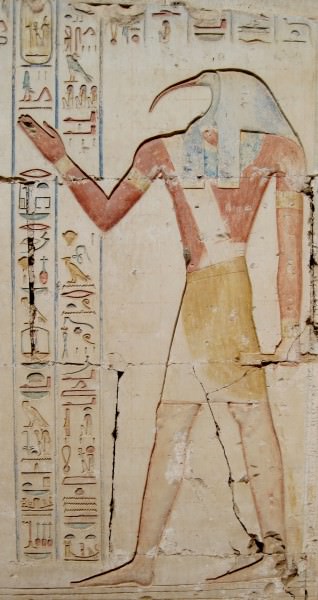
Thoth, Abydos Temple Relief
THOTH & THE DISTANT GODDESS
The motif of The Distant Goddess appears in a number of Egyptian myths but always has the same meaning no matter who the specific goddess is or where she has gone: Ra's daughter disagrees with him on some matter and leaves him to vanish into some far off land and someone has to be sent to bring her back; upon her return she brings some sort of transformation to the people. The Distant Goddess story also always involved the Eye of Ra, the all-seeing eye, which Ra needed on a daily basis; it was therefore imperative that the goddess be brought back quickly and the eye returned but she was too powerful to be forced and the task called for subtlety. Geraldine Pinch writes:
Ra chose Thoth to fetch this Distant Goddess back from a remote desert. Disguised as a baboon or monkey, Thoth accomplished his task through humility, cunning, and perseverance. According to one account he had to ask the goddess to come home 1,077 times (210).
As a reward for his services, Thoth was given the goddess Nehemtawy as his consort who, Pinch claims, was "a pacified version of the Distant Goddess" (210).
Thoth was also instrumental in the birth of the original five gods of Egypt. When Nut became pregnant by Geb at the beginning of the world, Ra (also known as Atum) was so angry he decreed she would not give birth on any day of the year. Thoth gambled with Iah, the moon god, for five days' worth of moonlight. He won the gamble and divided Iah's moonlight into five days of sunlight which were not part of the year as decreed by Ra. Nut was then able to give birth to each of her children (Osiris, Isis, Set, Nephthys, and Horus) on each of the days. Even though Ra had been angry with his daughter, Nut, he relented and honored Thoth for his part in getting around Ra's decree. Thoth was given a seat of honor in the sky boat which crossed the heavens by day and, by night, Thoth helped to drive away the serpent Apophis who sought to destroy the sun god. His participation in the overthrowing of Apophis linked him to the cycle of day and night and so intimately to the lives of human beings.
THOTH & THE WRITTEN WORD
Thoth created the written word people used to record their history and keep track of their daily lives. According to some stories, Thoth invented the word and gave it to humanity while, in others, Thoth was the creator and his consort Seshat gave words to the people. In still other variations, Thoth was the creator but Osiris or Isis gave words to humanity. In every case, Thoth is the creator of written language and the literary arts both for humans and the gods. Geraldine Pinch writes:
Thoth, the "excellent of understanding", observed and wrote down everything that happened and reported it to Ra every morning. As the record keeper of the gods he was paired with the librarian Seshat. Thoth and Seshat knew the future as well as the past. They inscribed a person's fate on the bricks on which their mother gave birth and the length of a king's reign on the leaves of the ished tree (210).
Thoth was therefore linked with the concept of fate even though this responsibility was shared, in different variations of the myths from different eras, with the Seven Hathors or other deities. As the record keeper of the gods, Thoth also kept account of the days of human beings. He is seen in a number of images keeping track of the days and numbering the years by which the Egyptian scribes were able to record the country's history.
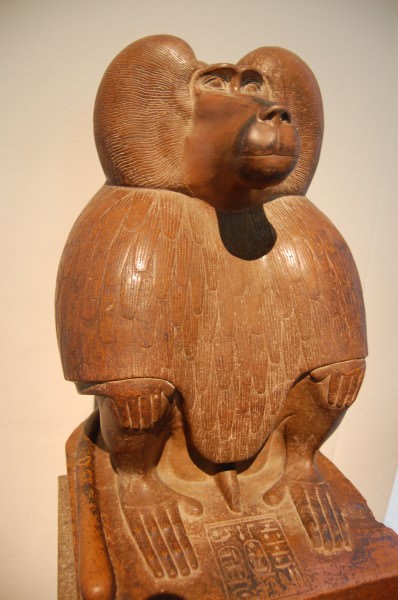
Thoth as a Baboon
Scribes, naturally, claimed Thoth as their patron and began each day honoring him. A statue from the 18th Dynasty shows Thoth as a baboon with the lunar disc on his head seated above a working scribe at his writing desk. The work of these scribes was, hopefully, approved of by Thoth who then gave leave to Seshat to house them in her immortal library and protect them in earthly ones. The concept of writing making the author immortal was well respected in Egypt as a scribe's work lived on after his death through the written words in books but was also known by the gods as Seshat kept the words in her heavenly books as well. Scribes had every reason to believe they would be welcomed warmly after death in the Hall of Truth and pass on to paradise in the Field of Reeds.
THOTH IN THE AFTERLIFE
Thoth appears regularly at the side of Osiris and Anubis in the Hall of Truth as the scribe who has kept accounts of the life of the soul of the deceased and who records the outcome of the weighing of the heart against the feather of truth. Scholar Richard H. Wilkinson writes:
In vignettes of the Book of the Dead [Thoth] stands before the scales which weigh the heart of the deceased and record the verdict. This role gave Thoth a reputation for truth and integrity and is seen in the common assertion that a person had conducted his life in a manner "straight and true like Thoth" (216).
His home in the afterlife, known as the Mansion of Thoth, provided a safe place for souls to rest and receive magic spells to help them against the demons who would prevent them from reaching paradise. His magic was also instrumental in the revitalization of the soul which brought the dead back to life in the underworld. The association of writing with magic gave rise to the belief that Thoth had written magical treatises based on all he knew of the heavens, the earth, and the afterlife, and that these books were hidden away to be found by the initiates of later generations. Pinch writes:
All funerary spells could be regarded as works of Thoth. A tradition grew up that Thoth had written forty-two books containing all the knowledge needed by humanity. Some of this was occult knowledge to be revealed only to initiates who would not misuse the power it gave them. The Greeks identified Thoth with their messenger god, Hermes. The body of literature known as the Hermetica claimed to preserve the teachings of Hermes Trismegistus (Thoth the Thrice Great). Hermes Trismegistus was eventually reinterpreted as a great thinker who had lived thousands of years in the past (211).
This claim regarding Thoth and the 42 books was first made by the church father Clement of Alexandria (c. 150-215 CE) who recorded in his Stromata that they were written by the god Hermes. Hermes the god was later understood as Hermes the wise man and in largely this manner the Book of Thoth has come into modern day understanding. Fictional representations of the Book of Thoth - written either by the Egyptian god, the Greek god, or the Greek sage - have appeared in books and films throughout the past century. The continued fascination with Thoth and his far-ranging knowledge is a testament to his enduring popularity.
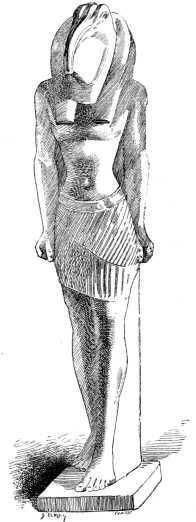
Thoth
WORSHIP OF THOTH & LEGACY
Thoth's main center of worship was at Hermopolis but he was widely venerated throughout the land of Egypt. As with other gods, his temples and shrines would have served as a focal point for the community and a resource for counsel, spiritual advice, and general aid in procuring food or medical attention. The priests of Thoth were highly educated scribes and his cult was closely associated with the ruling class. It was not only the monarchy or the educated elite who admired Thoth, however, as Wilkinson points out:
Thoth's appearance in the names of several New Kingdom monarchs shows important royal acceptance and patronage of the god's cult, but earlier references to offerings made in private tombs on the festival of Thoth also show the importance of this god to non-royal individuals and his worship appears to have always had a wide base among ancient Egyptians...Amulets of the god as an ibis or an ibis-headed man - sometimes holding the divine wedjat eye occur, though those depicting him as a baboon were more common. These amulets were worn in life, many presumbably by scribes. The wisdon and magical powers ascribed to Thoth meant that he was naturally invoked in many spells utilized in popular magic and religion (216-217).
His cult center at Hermopolis was extremely popular. Mummified ibises and baboons were sold to pilgrims coming to the festival as votive offerings to the gods. Excavations of the nearby necropolis of Tuna el-Gebel revealed thousands of these mummified animals. Wilkinson writes, "Another large burial ground for ibises and baboons was located at Saqqara and these catacombs well illustrate the continued widespread popularity of Thoth in the religion of the later periods (217). Thoth's enduring veneration is also recognized through the number of amulets to him which have been found from different time periods throughout Egypt's history.
Even today, Thoth is recognized as an important spiritual entity. Aside from those in the New Age, Wiccan, or Neo-Pagan communities who revere the god, he is one of the better known Egyptian deities in popular culture. The University of Cairo features Thoth on his throne as their logo and statuary of the god remains one of the most popular and recognizable, after images of King Tutankhamun, Queen Nefertiti, and the goddess Bastet, in the modern world.
LICENSE:
Article based on information obtained from these sources:with permission from the Website Ancient History Encyclopedia
Content is available under License Creative Commons: Attribution-NonCommercial-ShareAlike 3.0 Unported. CC-BY-NC-SA License